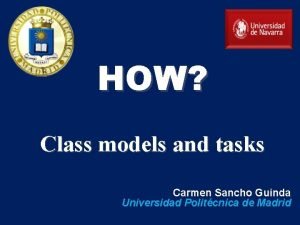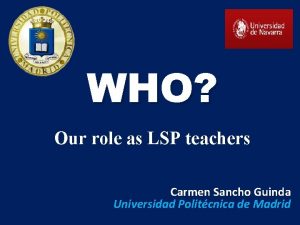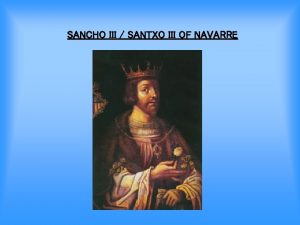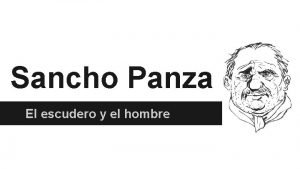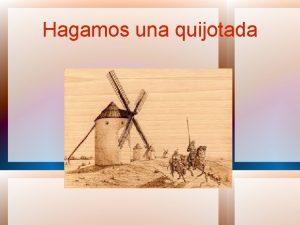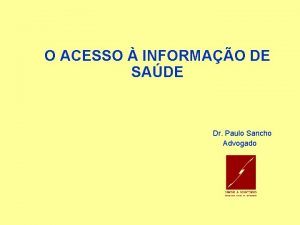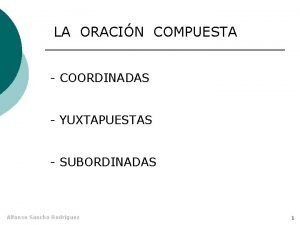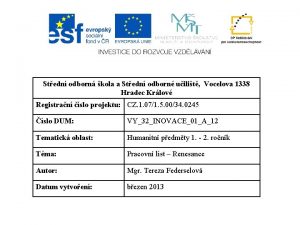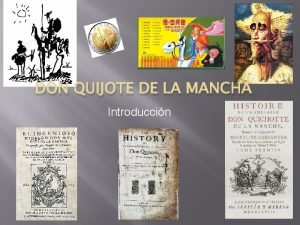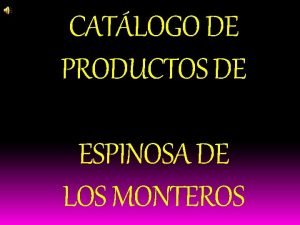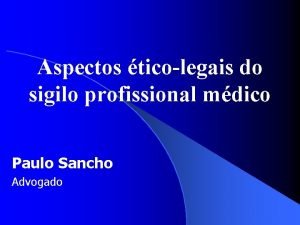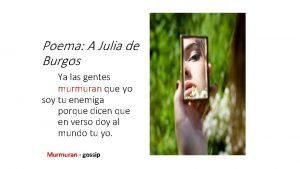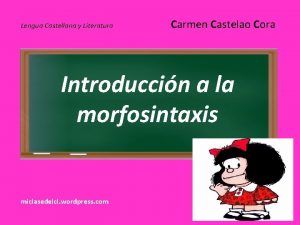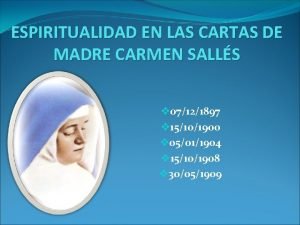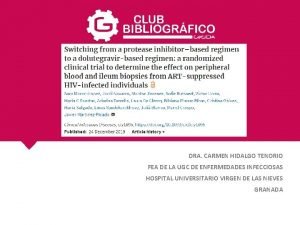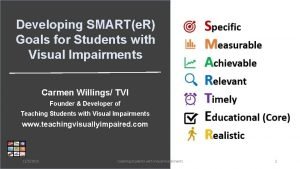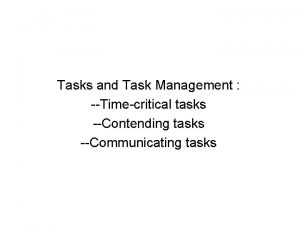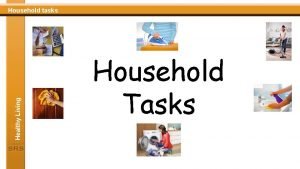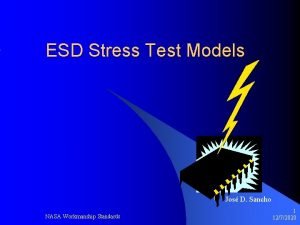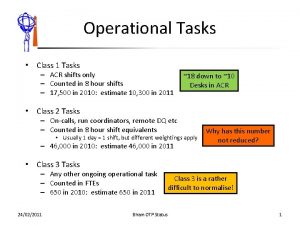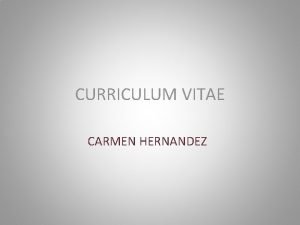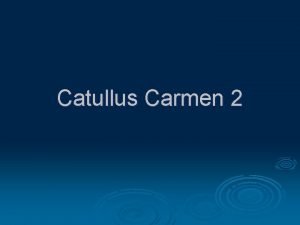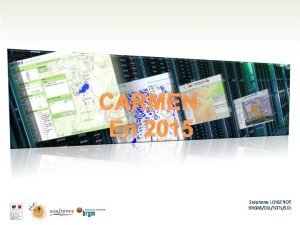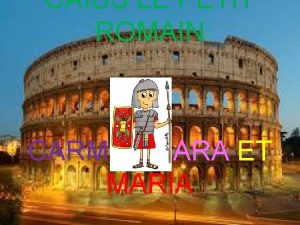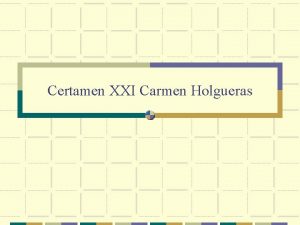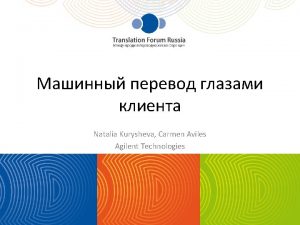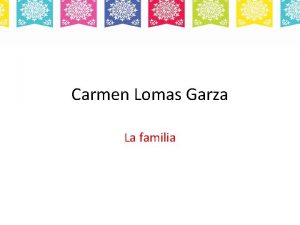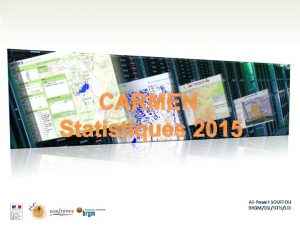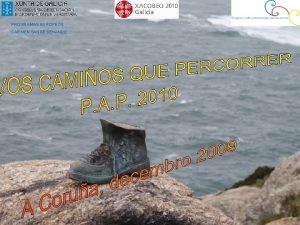HOW Class models and tasks Carmen Sancho Guinda

































- Slides: 33

HOW? Class models and tasks Carmen Sancho Guinda Universidad Politécnica de Madrid

OVERVIEW 1) Desirable in-class routines 2) What comes into play? Shared knowledge 3) Models and options DIAPOSITIVA 1

Desirable in-class routines DIAPOSITIVA 2

DESIRABLE IN-CLASS ROUTINES Exchangeable roles Mutual scaffolding TEAM-TEACHING GOAL-ORIENTED LEARNING STYLES KNOW-HOW TECHNOLOGIES HANDS-ON AUTHENTIC TASKS TOP-DOWN COOPERATION / INTERDEPENDENCE SHARED EXPERT ROLE in KNOWLEDGE CO-CONSTRUTION Broader immersion outcome STUDENT-FOCUS NEGOTIATION TAILOR-MADE TRANSVERSAL SKILLS PEER FEEDBACK PEER WORK LEARNER AUTONOMY INTEGRATED LEARNING: Language + Skills + Content LEARNING AWARENESS LEARNER RESPONSIBILITY DIAPOSITIVA 3

Feedback student committee for: Point at what was not clear or did not work Say what they liked the most / the least Detect mistakes Build a day-by-day glossary Keep a classroom logbook Students’ Involvement! DIAPOSITIVA 4

What comes into play DIAPOSITIVA 5

6 interrelated parameters 1. Teaching style (Ogborn et al 1996) Visualizer Co-thinker Storyteller Verbalizer Operator 2. Embedded genres Conversation Story/anecdote, joke Procedural description Demo Problem-solving Case study Discussion DIAPOSITIVA 6

3. Academic functions (Dalton-Puffer 2007, Hyland 2005) Definition Clarification/explanation Exemplification Inference Enumeration Contrast Relevance-marking Problem-solving 4. Metadiscourse functions (Hyland 2005) Goal announcement (“Today we are going to learn X”) Sequence (“Next we will see Y”) Stage-labelling (“So far we have seen A and B”) Endophoric signalling (“At the bottom of the table we can see X”) Topic shifting (“At the bottom of the table we can see X”) Code glossing (“In other words, X happens when…”) DIAPOSITIVA 7

Structural phases of the lecture (Young 1994, simplified) Start Inductive Deductive Tangible or ‘hands-on’ Introduction Elicitation Brainstorming Problem- or task-solving Teacher’s monologue Conversation Teacher-Students Content delivery Contrastive Argumentative Descriptive Narrative (chronological, cause and effect, problem-solution pattern) DIAPOSITIVA 8

Recapitulation Progressive Final Closure Visual Verbal Stereotyped vs. Self-made formulas Round-off summary Assignment DIAPOSITIVA 9

Co-building of repertoires Engagement features (Hyland 2005) Formulas of shared knowledge Personal pronoun use Asides Directives Questions Distinction between question types (Tsui 1995) Referential = authentic elicitation Display = knowledge-recall devices Rhetoric = metaphorically dialogic but not really ● interactive Check = ensure comprehension DIAPOSITIVA 10

Co-building of repertoires Engagement features (Hyland 2005) Formulas of shared knowledge Personal pronoun use Asides Directives Questions Distinction between question types (Tsui 1995) Referential Display = knowledge-recall devices Rhetoric = metaphorically dialogic but not really ● interactive DIAPOSITIVA 11

Lecture phase (Young 1994) Metadiscourse for Discourse Structuring (objectives, motivation, lesson outline) Exemplification (example markers, analogies, similes, metaphors) Content delivery (definition, classification, clarification, explanation, hypothesis, argumentation, narrative, description) Conclusion (language of inference, recapitulation, prediction) Discourse of the medium _Registers for face-to-face and online teaching _Endophorics and evidentials for visuals _Expression of perception, reporting, calculation, analysis _Action verbs linked to TICs and CMC (click, cut and paste, delete, drag, log on/off…) DIAPOSITIVA 12

Discourse of the embedded genre Typical metadiscourse and phraseology of online genres (blogs, chats, forums, mobile learning, videos, e-portfolios, e-mails, tutorials, twitters, etc. ) ● MOVES AND STEPS ● ASSOCIATED PROGRESSIONS Stories/anecdotes, jokes Case studies Seminars Graph commentaries Demos Experiments Reports Oral presentations Inductive Deductive Chronological Spatial Contrastive Problem-solution Known-unknown DIAPOSITIVA 13

Teaching style (Ogborn et al 1996) Questions Feedback tactics and its expressions Task-based teaching and its expressions ● Associated metadiscourse Project work and its expressions ● Key nouns, verbs and adjectives Peer work and its expressions ● BICS Involvement with students ● Shifts in formal and informal register ● Language of engagement Markers of teacher’s control Markers of degrees of learner autonomy DIAPOSITIVA 14

Models and options DIAPOSITIVA 15

Class planning RADIAL MODEL Dem o Aspect 1 activity Fixed slot 1 Proble m Discussi on Aspect 2 activity LESSON TOPIC INPUT Summary Aspect 4 activity FIXED SLOT MODEL Aspect 3 activity Fixed slot 2 Fixed slot 3 Definitio n, Problem, or quiz of the day Discussio n of the day Case study for next day’s discussi DIAPOSITIVA 16

TODAY’S LESSON (Fixed slots) Quiz / Definition / Problem / Graph commentary / Reading Brainstorming / Analysis of the day Case study discussion of the day Pair / peer work (e. g. hands-on analyisis of realia / competition, TBL, etc. ) Case study for the next day Summary of the lesson DIAPOSITIVA 17

Planning musts • Adapt materials to alloted time • Make room for students’ questions • Negotiate evaluating rubrics • Good communicator’s ‘golden rule’ – Say what you are going to say – Say it – Say what you have said

Text –Based (Genre) approach SOURCE = Feez, S. (1998). Text-based Syllabus Design. Sydney: Mc. Quarie University/AMES, p. 28. Developing the context DIAPOSITIVA 19

Task –Based approach (TBL) SOURCE = Willis, J. (1996). A Framework for Task-Based Learning. Longman Addison-Wesley. Pre-task (Teacher’s + students’ function) Task cycle (Task + Planning + Report) Language focus (Analysis + Practice) (+) Authentic communication, long-term motivation, reflection DIAPOSITIVA 20

• Pre-task – The teacher • Introduces and defines the topic • Uses activities to help students recall or learn useful concepts and language (words and phrases) • Ensures students understand task instructions • May play a recording of others doing the same or a similar task – The students • Note down useful words and phrases from the pre-task activities or the recording • May spend a few minutes preparing for the task individually DIAPOSITIVA 21

• Task cycle TASK – The teacher • Acts as monitor and encourages students – The students • Do the task in pairs/small groups. It may be based on a reading or listening text DIAPOSITIVA 22

• Task cycle PLANNING _The teacher • Ensures the purpose of the report is clear • Acts as language advisor • Helps students rehearse oral reports or organise written ones – The students • Prepare to report to the class how they did the task and what they discovered or decided • Rehearse what they will say or draft a written version for the class to read DIAPOSITIVA 23

• Task cycle REPORT _The teacher • Acts as chairperson, selecting who will speak next, or ensuring all students read most of their written reports • May give brief feedback on content and form • May play a recording of others doing the same or a similar task – The students • Present their spoken reports to the class, or circulate or display their written reports DIAPOSITIVA 24

• Language focus ANALYSIS _The teacher • Reviews each analysis activity with the class • Brings other useful words, phrases and patterns to students’ attention • May pick up on language items from the report stage – The students • Do consciousness-raising activities to identify and process specific language features from the task text and/or transcript • May ask about other features they have noticed DIAPOSITIVA 25

• Language focus PRACTICE _The teacher • Conducts practice activities after analysis activities where necessary, to build confidence – The students • Practise words, phrases and patterns from the analysis activities • Practise other features occurring in the task text or report stage • Enter useful language items in their language notebooks DIAPOSITIVA 26

Approaches for GBL and TBL • PPP = Presentation, Practice, Production – Provides a safe framework for production • TTT = Test, Teach, Test – Production occurs first, without any input or guidance from the teacher TEACHER-LED MODE GROUP-PAIR MODE Gives security More autonomy Opportunity to hear teacher talk Learners use the language for themselves (pupil talk) Tighter control over lesson content Less control DIAPOSITIVA 27

Adjustments for Clarity I • Support key statements with gestures – (without overacting) • Gloss acronyms and abbreviations – (mind lay audiences!) • Exemplify often – (visuals, tropes, analogies, cases…)

Adjustments for Clarity II – Speak more slowly – Pronounce more carefully – Pause more often – Break down info with headings – Choose simple words – Replace pronouns with nouns – Simplify syntax – Repeat more DIAPOSITIVA 29

• Be yourself Rapport – Confident, relaxed, naturally smiley • Balance sedentarism & mobility – Change positions, wander a little • Start from what your audience knows – Highlight shared knowledge • Interact with audience – Questions, humour (? ), anecdotes, eye contact • Mind audience background – Metaphors, similes, references!

Lectures as hybrid genres ● Text type ■ ● Genres ■ ● Demos, stories, case studies, reports, oral presentations, instructions, graph commentaries Textual progressions ■ ● Narrative, description, exposition, argumentation Inductive, deductive, chronological, contrastive, problem solution Shifting teaching styles ■ Flowing along a continuum of alternate leadership and democratic participation DIAPOSITIVA 31

Thank you! carmen. sguinda@upm. es DIAPOSITIVA 32
 Carmen sancho
Carmen sancho Carmen sancho guinda
Carmen sancho guinda Modals and semi-modals
Modals and semi-modals Quién era sancho panza
Quién era sancho panza Santxo
Santxo Paulo sancho
Paulo sancho Caracter de sancho panza
Caracter de sancho panza La libertad sancho es uno
La libertad sancho es uno Paulo sancho
Paulo sancho Alfonso sancho rodriguez
Alfonso sancho rodriguez Descripcion fisica don quijote
Descripcion fisica don quijote Terceiro rei de portugal
Terceiro rei de portugal Sancho panza charakteristika
Sancho panza charakteristika Charakteristika sancho panza
Charakteristika sancho panza Sancho panza era un labrador
Sancho panza era un labrador Apiespinosa
Apiespinosa Paulo sancho
Paulo sancho Carmen fought
Carmen fought Introduction to ooad
Introduction to ooad Difference between abstract class and concrete class
Difference between abstract class and concrete class Therapeutic class and pharmacologic class
Therapeutic class and pharmacologic class Java dynamic class loading
Java dynamic class loading Marianne bustamante
Marianne bustamante Opera carmen vsebina
Opera carmen vsebina Poesia de julia de burgos
Poesia de julia de burgos Carmen castelao cora
Carmen castelao cora Familia declinazione
Familia declinazione Terza declinazione greco
Terza declinazione greco Carmen costache
Carmen costache Coplas a la virgen del carmen
Coplas a la virgen del carmen Feliz dia de la madre carmen
Feliz dia de la madre carmen Carmen gamir
Carmen gamir Carmen hidalgo tenorio
Carmen hidalgo tenorio Smarte goals
Smarte goals
